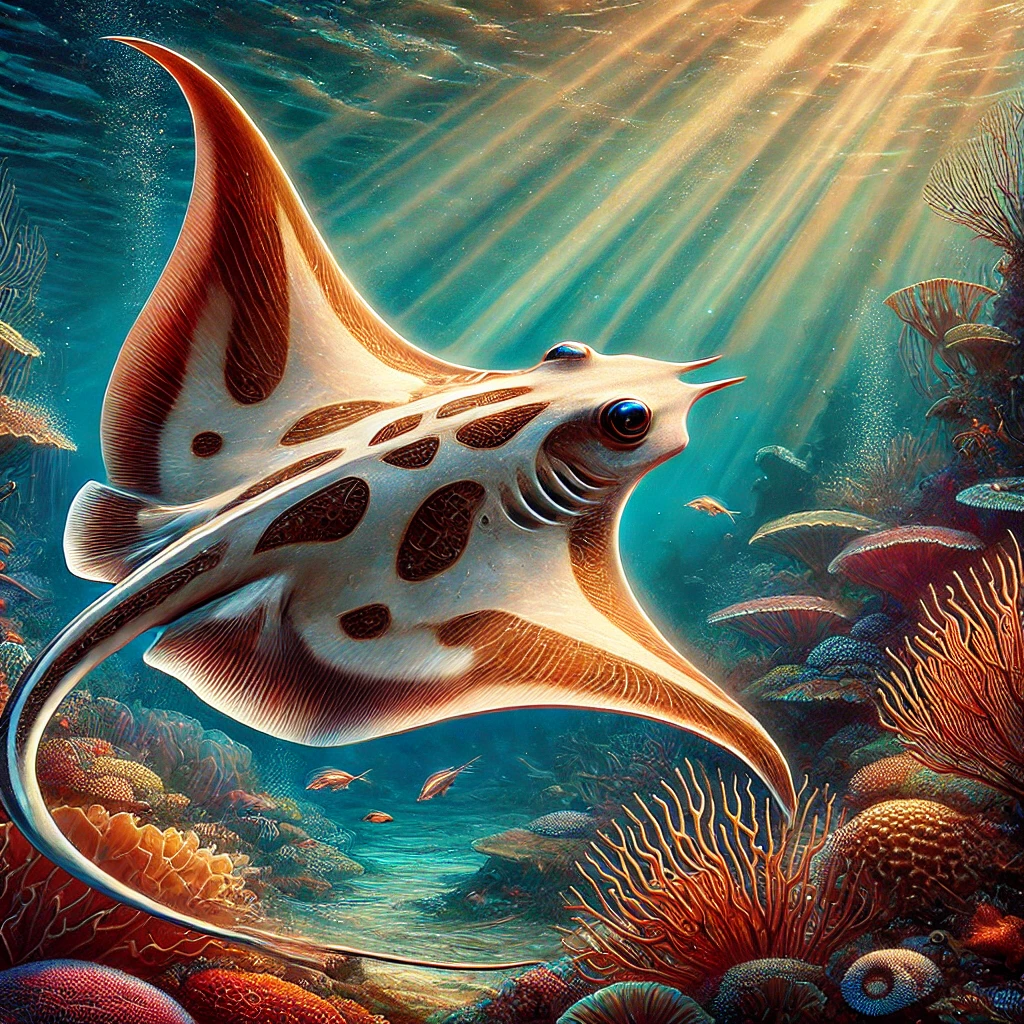Kniferays
“The sea has scalpels, child, and they swim with smiles.” -Old Wardsea nursery warning
Slipping like bronze shadows beneath the surface, the Kniferay is one of Everwealth’s most elegant and efficient mid-sized marine predators. While it shares distant ancestry with the common stingray, this creature has evolved into something far more cunning, and far more dangerous. Its body glints with reflective hues of tarnished ivory and dulled bronze, often mistaken for relics or submerged coin in shallow sunlit waters. But its true nature is betrayed only by its movement: a sudden lunge, a flash of metal, and the long, clean slice of skin parting like silk. The Kniferay is feared for its signature hunting method, gliding past prey in a blur and delivering precise, razor-sharp lacerations using its uniquely stiffened fins, honed not just for propulsion but for war. Faster than any common ray, capable of striking even larger predators, and known to hunt tactically over time, this silent executioner has earned its place in Everwealth’s maritime lore. It does not brawl. It bleeds you, then it waits.
Basic Information
Anatomy
The Kniferay spans 4-5 feet across, with a sleek, flattened body composed of dense, hydrodynamic cartilage and covered in smooth, interlocking scalelets that shimmer with bronze and ivory hues. Unlike the rounded shape of most rays, the Kniferay’s fins form a sharply tapering triangle, with both sets capable of shifting between limber and rigid at will. The outer edges are honed to a razor’s edge, capable of carving flesh, slicing nets, or lacerating unsuspecting prey during drive-by strikes. Its mouth is ventrally placed, lined with rows of small, backward-facing teeth meant for gripping slippery prey like shrimp and minnows. A long, flexible tail extends behind the body, tipped with a double stinger that delivers a paralytic toxin comparable to that of a reef jelly. The Kniferay’s eyes are asymmetrical, one set high for surface scanning, another embedded low for tracking prey beneath. This gives it nearly 360-degree visibility, and makes surprising one a rare feat.
Genetics and Reproduction
Kniverays breed through internal fertilization, with males delivering sperm via a twin-prong clasper near the tail base. Females gestate fertilized eggs for 4-5 weeks before laying them inside large decaying kills, usually from other predators or prey too large to consume whole. This behavior is not mindless, it is strategic. The decomposing flesh not only hides the leathery, capsule-like eggs but provides sustained food for hatchlings, who emerge fully equipped with venom glands and sharp fin-ridges.
Growth Rate & Stages
- Egg Capsule (0-1 month): Laid inside carrion, absorbing necrotic fluids.
- Hatchling (1-4 months): Palm-sized and already capable of hunting Elfshrimps.
- Juvenile (4-12 months): Begins fin-based hunting, tail stinger activates.
- Adult (1 year+): Fully developed, highly territorial.
Ecology and Habitats
Kniverays favor coastal reef drops, brackish river mouths, and kelp labyrinths where they can ambush prey or patrol wide arcs of territory. Common in the shallows off Wardsea, and The Bay of Knives, they move like heat through shadows, their glimmering hides refracting just enough light to remain unseen beneath the surface. Their chosen hunting grounds are often marked by silent waters, small fish swarming erratically, and the absence of anything bleeding, because if it is bleeding, the Kniferay is already watching.
Dietary Needs and Habits
Primarily carnivorous, the Kniferay feeds on:
- Elfshrimp.
- Minnows, anchovies.
- Wounded Shinefin or Griefscales.
- Carrion from larger predator kills.
- Glide past at burst speed.
- Rake its blade-fins along exposed flesh.
- Retreat and circle as the target weakens.
- Repeat until prey is incapacitated or exhausted.
Biological Cycle
Kniverays do not migrate but become more active in late spring and early fall, their fin-borne hormone glands stimulating greater aggression and mate-seeking behaviors. During these times, schools of Elfshrimp vanish entirely, either devoured or driven out. In colder months, Kniverays become ambush specialists, hiding beneath silt or reef ledges, waiting motionless for days if needed. This seasonal lethargy does not dull their precision, only their range.
Behaviour
Kniverays are highly tactical. They test prey responses, assess size and reaction speed, and will retreat from stronger foes only to return minutes later with a surprise cut. They hunt alone, and rarely engage in open combat unless cornered. They display parental planning, not protection, laying eggs in food is their only parental behavior, but it is a deliberate, calculated one. When housed in captivity (rare due to their agility and aggression), they have shown signs of problem-solving, using objects to trap live prey or wedge open feeding ports.
Additional Information
Perception and Sensory Capabilities
- High-contrast sight, especially in silty water
- Electroreception, able to detect muscle twitches of prey.
- Heat and vibration sensitivity, through lateral lines and tail base.
Scientific Name
Scalpelora spectrophin.
Origin/Ancestry
Kniverays are believed to have emerged shortly after the Schism, a magickally volatile offshoot of reef-dwelling rays exposed to residual energies and arcane weapon detritus.
Conservation Status
Kniverays are not endangered, but localized, thriving in carefully chosen hunting territories that they maintain aggressively. Their tendency to wipe out small prey populations has made them targets of spear-fishers like the Glintspear though many who go after them do not return. Harvesting their blade-fins for alchemical razors and tail venom for paralytic brews remains a lucrative, high-risk venture.



Comments